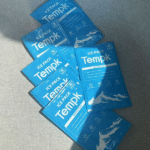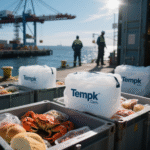Shipping temperature-sensitive products such as food, productos farmaceuticos, and medical supplies requires precise temperature control. hielo seco, both in the form of packs and bricks, has become one of the most reliable methods for ensuring that goods remain cold throughout transit. En esta guía completa, we will explore how dry ice works, its benefits for shipping, and how to effectively implement it in your cold chain logistics.
Cuáles son Dry Ice Packs and Dry Ice Bricks, and Why Are They Important?
El hielo seco es la forma sólida de dióxido de carbono (Co₂) and has an extremely low temperature of -78.5°C (-109.3°F). A diferencia del hielo normal, which melts and leaves behind water, El hielo seco se sublima directamente de un sólido a un gas, No dejando residuos. This unique property makes it ideal for shipping perishable goods, as it ensures no water damage while maintaining ultra-low temperatures.
Paquetes de hielo seco
These are pre-formed sheets or pouches that contain dry ice and are commonly used for short to medium-duration shipments. They offer flexibility and are easy to handle, making them ideal for smaller shipments.
Dry Ice Bricks
Dry ice bricks are solid blocks of dry ice, providing a longer sublimation period due to their larger mass and lower surface area. These are best for longer shipments, as they maintain cold temperatures for extended periods, making them ideal for bulk shipments or items that require prolonged cooling.
Benefits of Using Dry Ice for Shipping
1. Long-Lasting Cooling Power
Dry ice is incredibly effective at maintaining low temperatures for extended periods, much longer than regular ice. This is especially crucial for long-distance shipments or for products that need to be kept frozen for several days.
2. Sin residuos de agua
One of the most significant advantages of dry ice is that it does not leave any liquid residue. Mientras sublima, se convierte directamente en gas, ensuring that the goods being transported remain unaffected by water damage.
3. Ideal for Frozen Goods
Dry ice is perfect for shipping products like frozen foods, productos farmaceuticos, y muestras biológicas. It can keep these items at ultra-low temperatures, preventing spoilage and maintaining their integrity.
4. Lightweight Yet Efficient
Dry ice is denser than regular ice, providing more cooling power per unit weight. This helps reduce shipping costs, as less material is needed to achieve the same cooling effect.
How to Safely Handle Dry Ice During Shipping
Handling dry ice safely is critical for both the safety of those involved in shipping and the products being transported. Below are some essential safety tips for using dry ice in your logistics operations:
1. Protective Gear
Always wear protective gloves and eye protection when handling dry ice. This prevents frostbite and damage to the skin due to its extreme cold temperature.
2. La ventilación es clave
Dry Ice libera gas de dióxido de carbono mientras se sublima. Por lo tanto, it’s crucial to ensure that your storage areas and shipping containers are well-ventilated to prevent dangerous CO₂ buildup, which could lead to suffocation.
3. Almacenamiento adecuado
Dry ice should be stored in a well-ventilated area away from heat sources. Nunca debe almacenarse en un recipiente completamente sellado, as the buildup of pressure could cause an explosion.
Best Practices for Shipping with Dry Ice
1. Elija el embalaje correcto
Contenedores aislados de alta calidad, such as Styrofoam boxes or vacuum-insulated panels, should be used to protect the shipment and prolong the sublimation process of dry ice. Ensure the container allows for the safe release of CO₂ gas to avoid pressure buildup.
2. Calculate the Correct Amount of Dry Ice
When using dry ice for shipping, it’s essential to calculate the correct amount to ensure that the cooling duration is sufficient for the entire journey. You can use the following formula to help calculate the dry ice mass required:
masa (kilos)=(Thold hours24)×SR (kg per 24 horas)×(1+buffer)\texto{masa (kilos)} = izquierda(\fractura{T_{\texto{Hold horas}}}{24}\bien) \times \text{SR (kg per 24 horas)} \veces (1 + \texto{buffer})
Dónde:
-
T_hold_hours is the required hold time.
-
SR is the sublimation rate.
-
Buffer accounts for unexpected delays or deviations in the route.
3. Label and Document Properly
Ensure that your shipment is correctly labeled with “Hielo seco” o “Dióxido de carbono, Sólido,” and include the appropriate UN1845 identifier. También, provide a Shipper’s Declaration for Dangerous Goods if necessary.
Comparing Dry Ice Packs vs. Dry Ice Bricks
| Característica | Paquetes de hielo seco | Dry Ice Bricks |
|---|---|---|
| Duración del enfriamiento | Moderado (12-24 horas) | Largo (24-48 horas o más) |
| Mejor para | Short to medium-duration shipments | Long-duration or bulk shipments |
| Temperatura | Temperaturas ultra bajas (-78.5°C) | Temperaturas ultra bajas (-78.5°C) |
| Uso ideal | Small shipments and sensitive items | Larger shipments or extended transit times |
| Form Factor | Flexible and easy to handle | Dense and slow sublimation |
The Latest Trends in Dry Ice Shipping for 2025
1. Alternativas ecológicas
The demand for environmentally friendly shipping solutions has increased, and dry ice is no exception. Companies are exploring biodegradable materials that can replace dry ice to reduce the environmental impact.
2. Smart Shipping Solutions
En 2025, smart sensors and IoT-enabled temperature monitoring systems are revolutionizing dry ice shipping. These technologies ensure that temperature conditions remain stable throughout the entire shipping process, providing real-time data and enhanced visibility.
3. Hybrid Shipping Solutions
The rise of hybrid VIP (paneles aislados al vacío) combined with phase change materials (PCM) has been a game-changer in temperature-controlled logistics. These systems extend hold time while reducing CO₂ usage, providing a more sustainable solution for dry ice shipping.
FAQs About Dry Ice Shipping
Q1: How long can dry ice keep my shipment cold?
Dry ice can maintain its cooling power for 18 a 24 hours depending on factors like the amount used, packaging quality, and external temperature conditions.
Q2: Is it safe to use dry ice for shipping food?
Sí, El hielo seco es seguro para el envío de alimentos, as long as proper packaging is used to prevent direct contact with the product and to allow for gas release.
Q3: Can I use dry ice for shipping pharmaceuticals?
Dry ice is widely used for shipping pharmaceuticals, especially for items requiring ultra-low temperatures, como vacunas y productos biológicos.
Conclusión
Dry ice packs and dry ice bricks are invaluable for maintaining temperature control during shipping. By following best practices for handling, embalaje, y cumplimiento, you can ensure the safe delivery of temperature-sensitive goods. A medida que avanza la tecnología, dry ice shipping solutions will continue to evolve, offering more efficient, sostenible, and reliable options for businesses in need of cold chain logistics.
Siguientes pasos:
-
Review your current cold chain shipping methods and consider upgrading to dry ice for better temperature control.
-
Ensure your team is trained on the safe handling of dry ice.
-
Stay updated on the latest trends and innovations to keep your cold chain operations at the forefront of efficiency and sustainability.
Acerca de Tempk
Tempk is a leader in temperature-controlled logistics, providing dry ice and other cold chain packaging products. Our solutions are designed to ensure that your goods are delivered safely, maintaining their integrity throughout the journey.
For more information on our products and services, feel free to contact us or visit our website.























